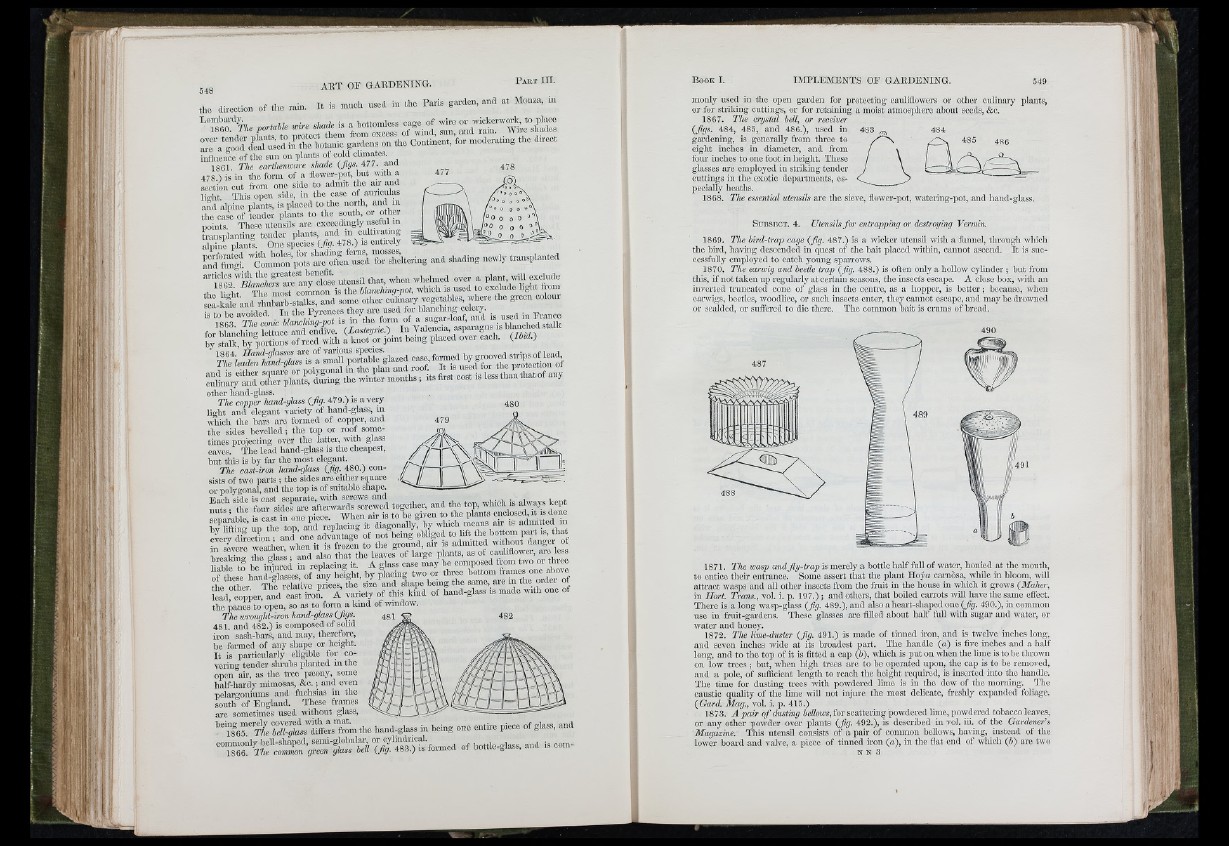
Il I
t e direction of the rain. It i« much nsed in the Parfr garden, and at Monza, in
portabb wire L i d M r M r é M ^
r a r é 'M r é M M ^ n M t t a n i o garden! on t e Continent, for moderating the direct
inflnonce of the sun on plants of cold climates,
1801 The earthenware shade (Jigs. 477. and
478 ) is in the form of a flower-pot, but with .a
section aut from one side to admit tho air and
lioht This open side, in t e case of auriculas
a?d alpine plants, is placed to t e north, and m
t e case of tender plants to the south, or othoi
points. These utensils arc exceedmgly nseiul m
by stMk! bytaoftions of reed with a knot or joint being placed over each. (B id .)
other hand-glass.
The copper hand-glass (fig. 479.) is a very
light and elegant variety of liand-glass, in
which the bars are formed of copper, and
the sides bevelled; the top or roof sometimes
projecting over the latter, with glass
eaves, th o lead hand-glass is the cheapest,
but this is by far the most elegant.
The cast-iron hand-glass (Jig. 480.) consists
of two p a rts ; the sides are either square
or polygonal, and the top is of suitable shape.
; t “ A t S " the other The relative prices, t e size and shape bemg t e s ^ e , are in the oidel /
k a dM lp e r , L a L a st iro í. A variety of this kind of hand-glass is made with one of
the panes to open, so as to form a kind of windosv.
The wrought-iron hand-glass (Jigs. - —
481. and 482.) is composed of solid
iron sash-bars, and may, te rc fo rc ,
be formed of any shape or height.
I t is particularly eligible for covering
tender shrubs jilantcd in the
open air, as t e tree paiony, some
half-hardy mimosas, &c.; and oven
pelargoniums and fuchsias in t e
south of England, These frames
are sometimes used without glass,
’'T I o L M Í * 0 imnd-glass in being one entire piece of g
■ T ; r é 5£ “ s : ' i = r é “ i s « f “ S > ~ < «■ “ M - - '■ ~
5, and
monly used in the open gai-den for protecting caulillowers or other culinary ¡ilants,
or for striking cuttings, or for retaining a moist atmosphere about seeds, &c.
1867. The crystal hell, or receiver
(figs. 484, 485, and 486.), used in 483 ^ 484
gardening, is generally from three to / ^ \ ta'Ms 485
eight inches iu diameter, and from
four inches to one foot in height. These
glasses arc employed in striking tcndcr
cuttings in the exotic depaitments, especially
heaths.
1868. The essential utensils a r e th e sieve, floAvcr-pot, Ava te ring-pot, a n d h a n d - g la s s .
SuBSr.CT. 4. Utensils fo r entrapping or destroying Vermin.
1869. The bird-ti-ap cage (fig. 487.) is a wicker utensil Avith a funnel, through Avliich
the bird, having descended in quest of the bait placed Avithin, cannot ascend. I t is successfully
employed to catch young sparroAvs.
1870. The earwig and beetle trap (fig. 488.) is often only a hollow cylinder ; but from
this, if not taken up regularly at certain seasons, the insects escape. A close box, Avith an
inverted truncated cone of glass in the centre, as a hopper, is better; because, when
eai-Avigs, beetles, Avoodlice, or such insects enter, they cannot escape, and may be drowned
or scalded, or suffered to die there. The common bait is crums of bread.
1871. The wasp and fly-trap is merely a bottle half full of water, honied at the mouth,
to entice thcii- entrance. Some assert that the plant Hoya carnosa, while in bloom, Avill
attract Avasps and all other insects from the fruit in the house in which it grows (Maher,
in Hort. Trans., vol. i. p. 197.) ; and others, that boiled caiTOts Avill have the same effect.
There is a long wasp-glass (Jig. 489.), and also a heart-shaped one (fig. 490.), in common
use in fruit-gardens. Tliese glasses are filled about half full Avith sugai- and Avatcr, or
Avater and honey.
1872. The lime-duster (Jig. 491.) is made of tinned iron, and is tAvclve inches long,
and seven inches wide at its broadest part. Tlie handle (a ) is five inches and a half
long, and to the top of it is fitted a cap (6), Avhich is put on Avhen the lime is to be throAvn
on low trees ; but, Avhen high trees ai-e to be operated upon, the cap is to be removed,
and a pole, of sufficient length to reach the height required, is inserted into the handle.
The time for dusting trees Avith powdered lime is in the dew of the morning. The
caustic quality of the lime Avill not injure the most delicate, freshly expanded foiiagc.
(Gard. Mag., vol. i. p. 415.)
1873. A pair o f dusting bellows, for scattering powdered lime, pOAvdcrcd tobacco leaves,
01- an y o th er poAvdcr over p lan ts (Jig. 492.), is described in vol. iii. o f the Gardener’s
Magazine. This utensil consists o f a p a ir o f common helloAvs, haA-ing, instead o f the
lower boai-d an d valve, a picce o f tinned iro n (a), in the flat end o f which (6) a rc tAvo
N N 3